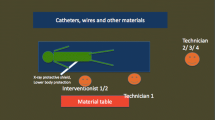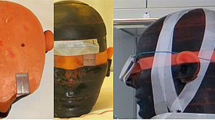Abstract
Purpose
The aim of this study was to compare dose-area product (DAP), entrance surface dose (ESD), and lens dose to radiologists for an old and a new X-ray system in a vascular interventional laboratory.
Materials and Methods
DAP, ESD, fluoroscopy time, number of images, and patient weight were recorded for patients undergoing the following four procedures: percutaneous transluminal angioplasty (PTA) and stenting (divided into two subgroups, lower extremities and pelvis), nephrostomy, and treatment for varicocele. Halfway through the registration period, the 9-year-old X-ray equipment was exchanged with a new system. Lens doses to the radiologist were measured.
Results
There was a reduction in DAP for all procedures: PTA lower extremities 31% (12–8 Gy cm2), PTA/stenting pelvis 67% (134–44 Gy cm2), nephrostomy 39% (7–4 Gy cm2), and varicocele 70% (37–11 Gy cm2). The reduction in number of images was 17% (158–131), 23% (153–118), 68% (2–1), and 31% (50–35), explaining a part of the dose reduction. The reduction in ESD was 33, 60, 38, and 46%. The differences in measured lens doses indicate a dose reduction in three procedures (19–53%) and an increase in one (56%), but differences are not statistically significant.
Conclusion
DAP and ESD from the X-ray system were reduced for all procedures. The reduction was greater in the more radiation-demanding procedures.

Similar content being viewed by others
References
Recommendations of the International Commission on Radiological Protection (2007) ICRP publication 103. Ann ICRP 37:1–332
Paulsen GU (2007) Strålevern Rapport 2009:4. Annual dose statistics from Norwegian Radiation Protection Authority 2007. Norwegian Radiation Protection Authority, Østerås. http://www.nrpa.no/dav/c7dbef056d.pdf. Accessed 19 July 2010
Vano E, Gonzales L, Fernández JM et al (2008) Eye lens exposure to radiation in interventional suites: caution is warranted. Radiology 248:945–953
Forskrift om strålevern og bruk av stråling (strålevernforskriften) (Norwegian Regulation of Radiation Protection and the Use of Radiation) (2003) FOR 2003-11-21 nr 1362. http://www.lovdata.no/cgi-wift/ldles?doc=/sf/sf/sf-20031121–1362.html. Accessed 19 July 2010
Cucinotta FA, Manuel FK, Jones J et al (2001) Space radiation and cataracts in astronauts. Radiat Res 156:460–466
Chumak VV, Worgul BV, Kundiyev YI et al (2007) Dosimetry for a study of low-dose radiation cataracts among Chernobyl clean-up workers. Radiat Res 167:606–614
Tsapaki V, Kottou S, Kollaros N et al (2004) Comparison of a conventional and a flat-panel digital system in interventional cardiology procedures. Br J Radiol 77:562–567
Bogaert E, Bacher K, Lapere R et al (2009) Does digital flat detector technology tip the scale towards better image quality or reduced patient dose in interventional cardiology? Eur J Radiol 72(2):348–353
Davies AG, Cowen AR, Kengyelics SM et al (2007) Do flat detector cardiac X-ray systems convey advantages over image-intensifier-based systems? Study comparing X-ray dose and image quality. Eur Radiol 17:1787–1794
Efstathopoulos EP, Brountzos EN, Alexopoulou E et al (2006) Patient radiation exposure measurements during interventional procedures: a prospective study. Health Phys 91:36–40
Miller DL, Balter S, Cole PE et al (2003) Radiation doses in interventional radiology procedures: the RAD-IR study. J Vasc Interv Radiol 14:977–990
Aroua A, Rickli H, Stauffer JC et al (2007) How to set up and apply reference levels in fluoroscopy at a national level. Eur Radiol 17:1621–1633
Vano E, Järvinen H, Kosunen A et al (2008) Patient dose in interventional radiology: a European survey. Radiat Prot Dosim 129:39–45
Dauer LT, Thornton R, Erdi Y et al (2009) Estimating radiation doses to the skin from interventional radiology procedures for a patient population with cancer. J Vasc Interv Radiol 20:782–788
Jensen K, Zangani L, Martinsen AC et al (2008) Linsedoser til personale ved intervernsjonsprosedyrer. Nordic Society for Radiation Protection—NSFS Proceedings of the NSFS XV Conference, Ålesund, Norway, May 26–30, 2008. Strålevern Rapport 13. Norwegian Radiation Protection Authority, Østerås, pp 61–64. http://www.nrpa.no/dav/12f17ba294.pdf. Accessed 19 July 2010
Lie ØØ, Paulsen GU, Wøhni T (2008) Assessment of effective dose and dose to the lens of the eye for the interventional cardiologist. Radiat Prot Dosim 132:313–318
Conflict of interest
The authors declare that they have no conflict of interest. This study was performed independently of the manufacturer of the devices used.
Author information
Authors and Affiliations
Corresponding author
Rights and permissions
About this article
Cite this article
Jensen, K., Zangani, L., Martinsen, A.C. et al. Changes in Dose-Area Product, Entrance Surface Dose, and Lens Dose to the Radiologist in a Vascular Interventional Laboratory when an Old X-ray System Is Exchanged with a New System. Cardiovasc Intervent Radiol 34, 717–722 (2011). https://doi.org/10.1007/s00270-010-0017-6
Received:
Accepted:
Published:
Issue Date:
DOI: https://doi.org/10.1007/s00270-010-0017-6




